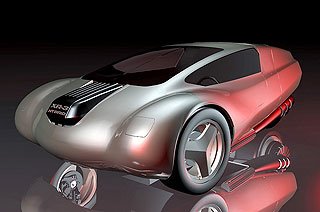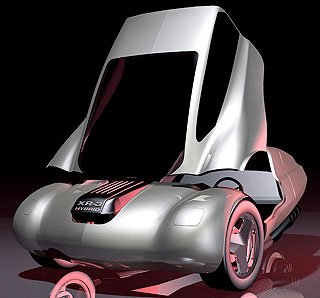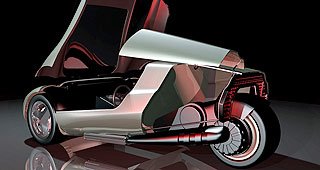2007 Riley Enterprises XR-3
(from Riley Enterprises Press Release) The XR-3 Hybrid is a super-fuel-efficient two-passenger plug-in hybrid that achieves 125 mpg on diesel power alone, 225 mpg on combined diesel and electric power, and performance like a conventional automobile. The design of the XR-3 Hybrid focuses on existing technologies and a vehicle “personality” that makes conserving energy a fun driving experience. It showcases the design ideas explored in Robert Q. Riley’s book, Alternative Cars in the 21st Century.


 At just 1300 pounds, this high-performance design combines lightening-fast acceleration, a maximum speed of 85 mph, and fuel economy of 125- to over 200-mpg.
At just 1300 pounds, this high-performance design combines lightening-fast acceleration, a maximum speed of 85 mph, and fuel economy of 125- to over 200-mpg.
Its clam-shell canopy and three-wheel platform boldly differentiates the XR-3 from conventional passenger cars. The vehicle’s hybrid power system, diesel engine, and low curb weight are the main ingredients of its super-high fuel economy and excellent performance. Acceleration equal to that of a conventional car and a maximum speed of 85 mph make the XR-3 Hybrid equally at home on freeways and surface streets.
Advanced safety features of a production XR-3 Hybrid will include occupant protection and crash avoidance systems. Enabling technologies already exist, and nothing new has to be invented.
Plans will be available so readers can build a duplicate of the XR-3 Hybrid prototype, or convert their own car into a significantly more fuel-efficient vehicle. Readers will understand the factors that influence fuel economy, and learn how to make any car achieve greater fuel economy. The XR-3 Hybrid gives enthusiasts and experimenters the opportunity to significantly reduce their transportation expenses and have fun doing it. On a broader level, the vehicle is a highly visible example of the kinds of vehicles that could help reduce personal mobility energy on a global scale.
Styling Makes an Implied Promise
The driving experience is defined by the vehicle’s layout and styling – it's “theme" or "personality.” The vehicle theme says: “This is what I am and this is what I do." It’s a statement that’s on a visual level, and it’s maintained throughout the ambiance of the vehicle. Mechanical design simply supports that statement. “Once we decide on the basic architecture of the vehicle, styling is the first thing that’s done,” says Riley. “It’s the most intangible quality of the design, but it provides a visual marker for what we are trying to achieve through mechanical design. Styling makes an implied promise, and then it’s up to the mechanical designers to deliver on that promise.”
The Technology of Fuel Economy
The vehicle’s performance and fuel economy comes from a combination of two fundamental design factors. First, it’s essential to keep the vehicle as light as possible in order to reduce the amount of mechanical "work" that has to be done. The method of getting rid of unwanted mass while still keeping the car’s mechanical benefits demands good design and modern materials. Once the amount of "work" has been minimized, then the other part of the equation is to do the remaining "work" as efficiently as possible. And that’s where the hybrid power system comes in. So the fundamental approach is very simple. The key is in the execution.
New types of products that rely more on vehicle packaging and market positioning could play an important role in reducing global energy demand. Significantly downsized vehicles - smaller, lighter, highly fuel-efficient personal mobility products - could help turn the tide against escalating energy demand and open new markets in the process.
Consumer Perceptions and Choices
Everyone understands that small, super-efficient cars would help the environment and reduce imported oil. But industry has been slow to see marketing opportunities and create products of this category that capture the imagination of consumers. The XR-3 Hybrid is designed to explore vehicle packaging and styling, with an eye toward creating a new design theme and market positioning for alternative personal transportation products. We call it a “Personal Mobility Vehicle.”
To paraphrase the lead quote from John Locke, the ideas and images in the minds of designers invisibly guide them toward particular design options. A product’s “character” naturally emerges from the collective mind-set of its designers. Consumer appeal of any alternative mobility product depends on the ideas and images in the minds of its creators, not on the core idea of saving energy and emissions through size/mass reduction. In order to enjoy success in a consumer market, significantly different vehicle types - Personal Mobility Vehicles - must be rendered in ways that create new appeals of their own. And energy savings and emissions reduction must be positioned as secondary benefits. Or stated differently, a consumer vehicle’s environmental benefits can be an effective motivator only in terms of providing a rationale for a purchase that is, in fact, based largely on the product’s emotional appeal.
The XR-3 focuses on the power of “design” to influence consumer perceptions and choices. It points to a new category of personal mobility products that are neither automobiles nor motorcycles.
The Power of Design
The idea that vehicle theme or personality - vehicle “design” - has the power to influence global energy demand goes against conventional thinking. Consider, however, that in the 1990s vehicle personality influenced automobile energy intensity in the negative with lifestyle vehicles that pushed energy use upward. The popularity of SUVs is a good example of how an "image" can influence choices, and those choices can lead to significantly higher fuel consumption.** Hardly anyone buys an SUV to go trailblazing. Consumers are turned on to the personality of SUVs, the vehicle theme, and they buy them to drive around the city. New-car average fuel economy has plunged in recent years, mainly because of the power of design to shift purchasing choices toward trucks. As of year 2000, light trucks accounted for roughly half of all new car sales. This same dynamic can work in the reverse.
**It might be argued that greater utility, rather than vehicle design, is responsible for the popularity of SUVs. But consider that station wagons and panel trucks have been around almost since the inception of the automobile. And it was only when carmakers connected with consumers through “design” that trucks began to replace family sedans in the personal mobility market.
Advanced Safety Systems
Extremely small and lightweight vehicles operating in an environment with high-mass vehicles present inherent safety challenges due to the large transfer of energy to the smaller vehicle during a crash. Although small-car occupant protection is technically feasible, crash avoidance is the superior approach. According to NHTSA, the emphasis in highway safety is expected to shift away from crash survival and toward crash avoidance by year 2020. But the technology for crash avoidance already exists. Crash avoidance capability will become standard equipment on production vehicles like the XR-3.
Plug-In Hybrid Architecture
The XR-3 is designed as a “plug-in hybrid.” This makes it possible to drive on battery power alone on trips of about 40 miles. In other words, on short trips you never have to turn on the diesel engine. And when both the diesel and the battery-electric systems are used together, and the car is driven conservatively, fuel economy increases to over 200-mpg. Fuel economy is about 125-mpg on diesel power alone.
Today’s hybrids are called “mild hybrids” or “charge-maintaining hybrids”. They use the electric system to help with acceleration. You can drive on battery power alone, but only for a short distance – around the block, for example. The battery pack is typically used to provide bursts of power for brief periods of acceleration. The combustion engine then recharges the battery between periods of acceleration. But fuel economy suffers while the battery is being recharged. That’s why today’s hybrids do not provide much advantage in fuel economy over a well-designed conventional car.
In order to get the full benefits of a hybrid power system, you have to switch to a plug-in hybrid architecture like the XR-3. Plug-ins will be the next generation of hybrid vehicles. A plug-in hybrid simply means that part or all of the vehicle’s energy is taken from the grid system where it is cleaner and less costly to produce. Most of the world’s automakers are now working on plug-in hybrids.
Virtually Unlimited Options for the Builder
The plug-in power system architecture also allows much greater flexibility in power system choices. With a mild hybrid, like the Honda Insight and the Toyota Prius (also called “charge-maintaining hybrids”), proper control of the power system depends on the fact that the subsystems - the internal combustion engine (ICE) and electric systems - are selected in advance and controlled by a computer. The computer, however, has to be programmed for the specific output characteristics of the two systems. Any modification in either of the power systems (electric or ICE) causes a mismatch with the control system. The computer control system cannot, on its own, account for changes in the power system. So whenever a change is made, the computer has to be reprogrammed to account for the change.
With a plug-in hybrid system, configured like the system in the XR-3, you are free to add a larger or smaller ICE, or even switch to a gasoline engine, without having to reprogram the control system. You can also build the car as a conventional ICE-powered car, or a full battery-electric car. So the options are greatly expanded with the plug-in hybrid power system.
With the XR-3, the two front wheels are powered by the ICE engine, and the single rear wheel is electric powered. The two power systems are not integrated within the vehicle. The connection between the ICE and the electric power systems is provided by the ground. Proper phase-in between the two power systems is handled by a simple throttle mechanism, and a dash-mounted switch to select between ICE power, electric power, and dual power modes. In the dual power mode, the XR-3 will have lots of burst power for outstanding acceleration. If you were to use this acceleration potential to its fullest, fuel economy would be reduced to something on the order of 150 mpg over a 70 mile trip. Fuel economy will vary according the particular components chosen for the power system, and how heavy you are on the throttle pedal. Performance figures quoted here are for a system configured just like the prototype. Plans will provide the information necessary for you to select different components if you want to.
Future Developments
The XR-3 is being developed as a plans-built vehicle. Body and chassis kits are slated to follow along after the release of the plans.
A kit, however, will be unnecessary. The XR-3 will be constructed using the same techniques used to build Tri-Magnum. Click on FRP/foam composite for a document that shows the composite system used to build the body for Tri-Magnum. The XR-3 body may be built of carbon fiber over foam or conventional fiberglass over foam. Both systems are designed for the home craftsman using virtually identical techniques.
About the Designer
Robert Q. Riley consults for corporate and private clients on new product design and product strategies. He promotes environmentally friendly technologies, and writes and speaks on the subject of alternative automobile design. He has chaired conference workshops and spoken at industry, scientific, and academic events, including the Global Energy Future symposium (Columbia University), the World Car Conference, and the Northwest Alternative Fuels Conference. He consulted on the Different Roads automobile exhibit at New York’s Museum of Modern Art, and was a panelist on the museum’s daylong symposium on the future of the automobile. He was one of the two U.S. technical consultants selected by Delcan Corporation to assist with Transport Canada’s Sustainable Transportation Technology Forecast.
Mr. Riley is the author of Alternative Cars in the 21st Century: A New Personal Transportation Paradigm (Society of Automotive Engineers, 1994), and Alternative Fuels for Spark-Ignition Engines (for a volume on Motor Gasoline in the series, Critical Reports on Applied Chemistry, Royal Society of Chemistry & Society of Chemical Industry, U.K., 1995). The Second Edition of Alternative Cars in the 21st Century, with a Forward by Dr. Paul MacCready, was published in 2003.
© Source: article on seriouswheels
We need your comments below >>